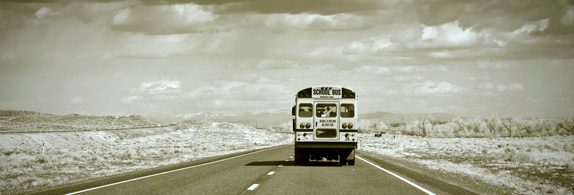
The most beautiful classroom in the world lives in the middle of a Southwestern painting. The vaulting blue sky gives way to the magnificent whites of the billowing clouds--smoke signals from the gods. Their shadows fancy dance on the hills. Triangulated among the peaks of the Jemez, Sangre de Cristo, and Sandia mountains, our classroom provides a bridge from a traditional community to the modern world.
Each morning, a bus travels the dirt roads of the Pueblo and fills with bleary-eyed children. Nearly 900 years ago, these children’s ancestors settled the fertile soil near the confluence of the Galisteo and Rio Grande rivers. During the ensuing centuries, the people survived conflict with neighboring tribes, drought, famine, and the arrival of the conquistadors. The community lost its original name Guipi, “The Unknown,” to its patron saint when the imperialists ordered a Catholic mission to be built by slave labor. During the Pueblo Revolt of 1680, the Spanish chose the community’s strategic location to be the inquisition's political, religious, and military seat for the reconquest of New Mexico’s indigenous peoples. The once sought after land is now forgotten by commuters and travelers alike, the blight unknown.
While the Pueblo’s history tells of change, threats, and perseverance, its modern conditions speak of vanishing. The Galisteo no longer runs because Santa Fe bleeds its snow melt for growth. The Rio Grande has been dammed, so humans control its flow, and floods no longer give birth to green springs. The once fertile valley thirsts. As the bus travels up the eroding hills held together by the shallow juniper roots, the hopes for survival of enduring wisdom and timeworn language bounce in their seats drifting between sleep and consciousness.
The bus travels east on the only road that connects the Pueblo to I-25. A lone gas station, the last stop for the departed, separates our classroom from the interstate and the opportunities of the state’s capital to the north and Albuquerque to the south. Our classroom does not shine with beauty because of its setting, history, or circumstance. The beauty is in its members.
As the bus unloads, I give high fives to each student. At age nineteen, I drive 42 miles every day to be an aid in Ms. Yazzie’s classroom. If current statistics hold true, nearly one-third of these children are considered obese, fewer than six percent will graduate from college, but four out of five will speak their native language, Keresan. These statistics do not speak of success or failure. As our second graders disembark one by one, they tell stories; we should listen.
First comes Angel. Her eyes flood her bifocals. Early signs of juvenile diabetes take a toll on her young body. Last week, she told me the sheriff took her brother away because he was smoking the pipe.
Then, Juan steps off the bus. He wears a collared, button-up shirt that someone took the time to tuck in this morning. By the end of the day, his professional dress will come off, and Juan will puff up his chest instigating conflict in a tank top the second graders call a “wife beater.” Of the eight adults living in Juan’s house, only two hold steady jobs.
Juan is followed by Stephen, who has a scar running along the contour of his skull from its base to his left eye. Last year, a horse hoof crushed Stephen’s skull, and, after hours of surgery, his damaged brain was re-incased in the fragments of a makeshift cranial vault. He cannot control when he has to go to the bathroom, so multiple times a day he suffers the embarrassment all children dread. Most of these children are caught between worlds; Stephen belongs to none.
Sharral follows Stephen because she quietly sat next to him on the bus. Her kindness and patience trump mine. She does not speak, and we do not know why. She smiles at me, and her eyes tell me it will get better.
Next comes Clarence. Most mornings, he cannot join the others until he eats, so this morning I brought him oatmeal and a banana, his favorite. Other mornings, he curls up in the corner and sleeps until lunch. He is another unknown, but community leaders only shake their heads when asked about his situation at home.
Finally, Sherman jumps off the bus. He smiles to fill the sky and acknowledges the gods’ message. Sherman loves to learn about weather and natural disasters. He likes to pretend he has a news camera, shooting a segment for the five o’clock broadcast. He tells me Joe Diaz, the channel two weatherman, is his uncle. For two years while organizing a program to give books to New Mexico’s underserved children and start community libraries, I pulled books for Sherman on clouds, tornados, and volcanoes because he had read every book of interest in the school’s library. Once his grandma told me he imagines a different family because he is not proud of his.
Along with a backpack provided by a food bank, these seven-year-olds carry the weight of domestic violence, alcoholism, poverty, unemployment, war, neglect, and hunger. From this brutality, we work together to be the most beautiful classroom in the world.
In our classroom, we do peace. We eat together and share food, so Clarence can listen to others and not his stomach. We solve problems cooperatively and go beyond the violent defaults to mediate conflict when Juan cocks his fist. We take turns and grow our patience as Sean completes tasks at his pace. We listen to others. Sharral is the best. She carefully takes in what others say and offers grace in her reassuring eyes. We promote each other where we are. We don’t try to fix, but Angel contributes the kindest of jokes to bring levity to the heaviest of situation. We care for each other. Sherman tells us to bring our coats because it will rain tomorrow.
The unknown awaits these children as it awaits the world, and we must decide what we will teach.
(Photo by Joao Martinho)



Responses to “The Most Beautiful Classroom in the World”